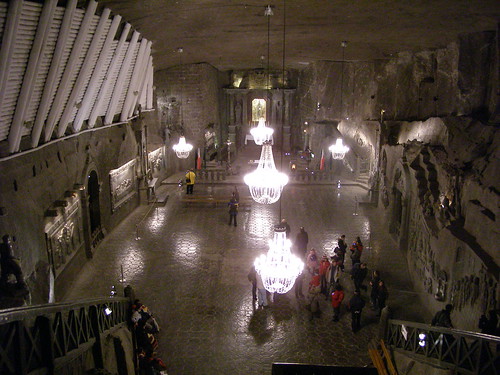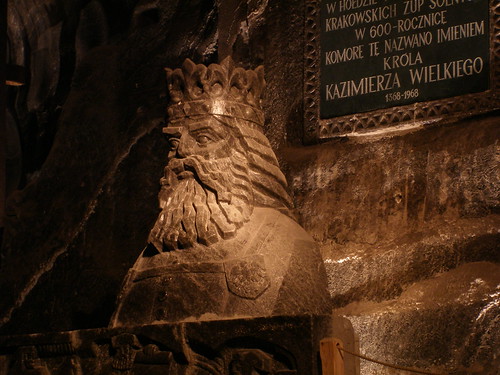The Wieliczka Salt Mine, located in the town of Wieliczka in southern Poland, lies within the Kraków metropolitan area. The mine continuously produced table salt from the 13th century until 2007 as one of the world's oldest operating salt mines. It is believed to be the world's 14th-oldest company still in operation.
The mine's attractions for tourists include dozens of statues and an entire chapel that has been carved out of the rock salt by the miners. About 1.2 million people visit the Wieliczka Salt Mine annually.
Commercial mining was discontinued in 1996 due to low salt prices and mine flooding.

The Wieliczka salt mine reaches a depth of 327 meters and is over 300 km long. It features a 3.5-km touring route for visitors (less than 1% of the length of the mine's passages) that includes historic statues and mythical figures. The oldest sculptures were carved out of rock salt by miners; more recent figures have been fashioned by contemporary artists. Even the crystals of the chandeliers are made from rock salt that has been dissolved and reconstituted to achieve a clear, glass-like appearance. The rock salt is naturally gray in various shades, so that the carvings resemble unpolished granite rather than the white or crystalline look that many visitors expect. The carvings may appear white in the photos, but the actual carved figures are not white. 
At the end of the tour, there is a large chapel and reception room that can be reserved for private functions such as weddings or private parties. Also featured is a large chamber with walls carved to resemble wooden chapels built by miners in earlier centuries; an underground lake; and exhibits on the history of salt mining. The Wieliczka mine is often referred to as "the Underground Salt Cathedral of Poland." It also houses a private rehabilitation and wellness complex.
Over the centuries, visitors to this site have included Nicolaus Copernicus, Johann Wolfgang von Goethe, Alexander von Humboldt, Fryderyk Chopin ( 23 July 1829), Dmitri Mendeleyev,Bolesław Prus (1878), Ignacy Paderewski, Robert Baden-Powell, Jacob Bronowski (who filmed segments of The Ascent of Man in the mine), Karol Wojtyła (the later Pope John Paul II), former U.S. President Bill Clinton, and many others. During World War II, the salt mine was used by the occupying Germans as facilities for war-related industries. To get down to the 64-metre level of the mine, visitors must descend a wooden stairway of 378 steps. After the three-kilometer tour of the mine's corridors, chapels, statues and lake, 135 metres underground, visitors take an elevator back up to the surface. The elevator holds 36 people (nine per car) and takes some 30 seconds to reach the surface (although the wait to board the elevator can be long)

"A journey of a thousand miles must begin with a single step." -- Lao Tzu Copyright © Demetrios the Traveler







No comments:
Post a Comment